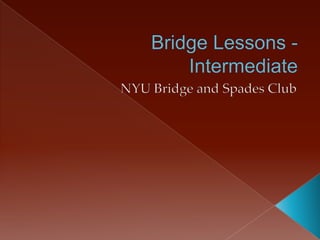Lesson 9 Searching For Slams
- 1. Bridge Lessons - IntermediateNYU Bridge and Spades Club
- 2. Lesson 9Searching for Slams
- 3. Point System for Slams/Grand Slams500/750 (NV/vul) points for slam (6-level contract bid and made)1000/1500 (NV/vul) points for grand slam (7-level contract bid and made)For both kinds of contracts, add the 300/500 point game bonus as wellThe point bonus for slams and grand slams is very huge. Thus, knowing how to search for them is very helpful.
- 4. Cue BidsAfter a suit has been agreed upon, one may initiate a slam try using cue bidsCue bids show 1st or 2nd round control in the suit bid i.e. A, K, void or singletonE.g. 1H ŌĆō 3H ŌĆō 4C is a cue bid showing 1st or 2nd round control in clubsMost of the time, whether a bid is a cue bid is based on common sense. Usually after a fit has been established, thereŌĆÖs not much of a point showing another suit. Shortness is generally more helpful
- 5. 4NT BlackwoodGiven that 3NT is a game level contract, the 4NT bid is otherwise quite useless. Hence, bridge players have come up with an alternative use for it ŌĆō to ask for aces.After a suit has been established, bidding 4NT can be treated as Blackwood. The replies are as such:5C = 0/4 aces5D = 1 ace5H = 2 aces5S = 3 acesAfter the reply, Blackwood bidder can opt to bid 5NT to ask for kings as well
- 6. RKC 4NTModern bridge players feel that Blackwood asks for too little, and have thus come up with the Roman Key Card 4NT bid.The key cards are the 4 aces and King of trumpReplies:5C = 0 or 3 of the key cards5D = 1 or 4 of the key cards5H = 2 or 5 of the key cards, denies Q of trump5S = 2 or 5 of the key cards, confirms Q of trumpThis is known also known as the 0314 conventionSome (including myself) choose to invert the 5C and 5D bids (this is known as 1430). See the next section for the reason
- 7. Rebids after RKC 4NTSchool of thought 1: bid 5NT to ask directly for number of outside (non-trump) kingsSchool of thought 2: bid 5NT to ask for specific kingsSchool of thought 2: bidding 5NT confirms possession of the Q of trump and asks for specific kings. However, another bid can be made to ask for the Q after 4NT ŌĆō 5C/D.
- 8. Rebids after RKC 4NT ŌĆō School of Thought 15NT asks for Kings in a similar fashion to Blackwood6C = 0 kings6D = 1 king6H = 2 kings6S = 3 kingsThis allows the RKC bidder to ask for the most information. Unfortunately, this also means singletons are diminished in importance, the Q trump is of no importance and may result in overbidding e.g. 6H reply when requiring all the kings to make 7D (D is agreed suit)
- 9. Rebids after RKC 4NT ŌĆō School of Thought 2To circumvent the problem in the first school of thought, some bridge players opt to ask for specific kings5NT asks for partner to bid a specific outside king at the 6th level e.g. in hearts contract with diamond king, bid 6DWith 2 or more outside kings, partner will bid grandslam directly. With no outside kings, partner will bid slam directlyThis may also lead to problems when partner is holding spade king in a hearts contract
- 10. Rebids after RKC 4NT ŌĆō School of Thought 35NT rebid guarantees possession of the Q of trumpWithout Q of trump, bid the next cheapest bid to ask for Q of trump and specific kingsE.g. 4NT ŌĆō 5C ŌĆō 5D is asking for Q of trump and for specific kings.You cannot bid the next cheapest bid if it is the agreed suit e.g. 4NT ŌĆō 5D ŌĆō 5H with H as agreed suit is a stopping bid, not an asking bidWithout the Q, partner bids the contract at the 5 level. After this bid, you may still choose to use 5NT to ask for specific kings, though generally the right contract here is the slam, not the grand slam
- 11. Rebids after RKC 4NT ŌĆō School of Thought 3With the Q, partner will bid a specific kingE.g. with outside K club with hearts as agreed suit4NT ŌĆō 5D ŌĆō 5S ŌĆō 6C shows Q hearts and K clubNotice H was skipped as it is the agreed suitWith >1 king, partner should bid the cheapest kingE.g. with outside K spades and clubs with hearts as agreed suit4NT ŌĆō 5C ŌĆō 5D ŌĆō 5S shows Q hearts and K spadesAfter partnerŌĆÖs specific king bid, you can bid another suit to ask for king in that suit. E.g. after 4NT ŌĆō 5C ŌĆō 5D ŌĆō 5S, if you need K club to make grand slam, bid 6C. Partner can then bid the grand with the K club or slam withoutPrimary benefit of this school of thought: more discussion at a lower level. Also, when missing one key card, the partnership can decide if a slam is still makeable by asking for Q trump
- 12. Reason for using 1430 vs 0314In general, you are more concerned about whether partner has the Q of trump when partner has only 1 key card, not when partner has 0 or 3 key cards. In general if partner has 3, youŌĆÖre making grand; and if partner has 0, youŌĆÖre not going to slam.Thus, using 5C as 1 or 4 is more helpful as 5D can be used as the Q asking bid. In hearts contracts especially, you can see the difference. 4NT ŌĆō 5D will lead to an inability to ask for Q hearts without going to slam level
- 13. Gerber (revision)Works over NT openers and some NT rebids4C bidPartner bids 4D with 0/4 aces, 4H with 1 ace, 4S with 2 aces or 4NT with 3 aces













